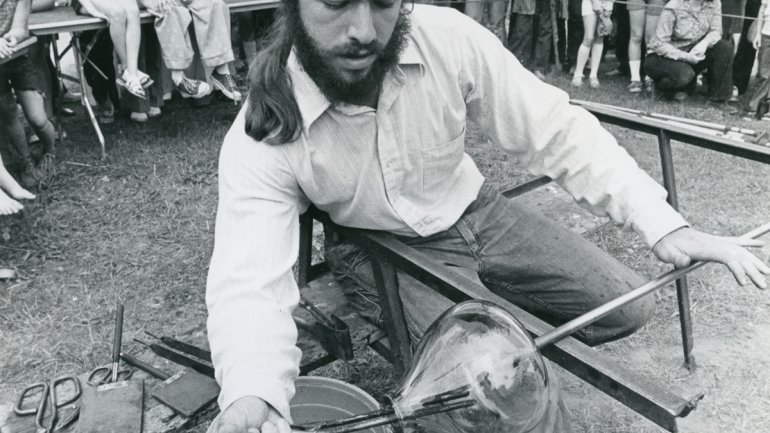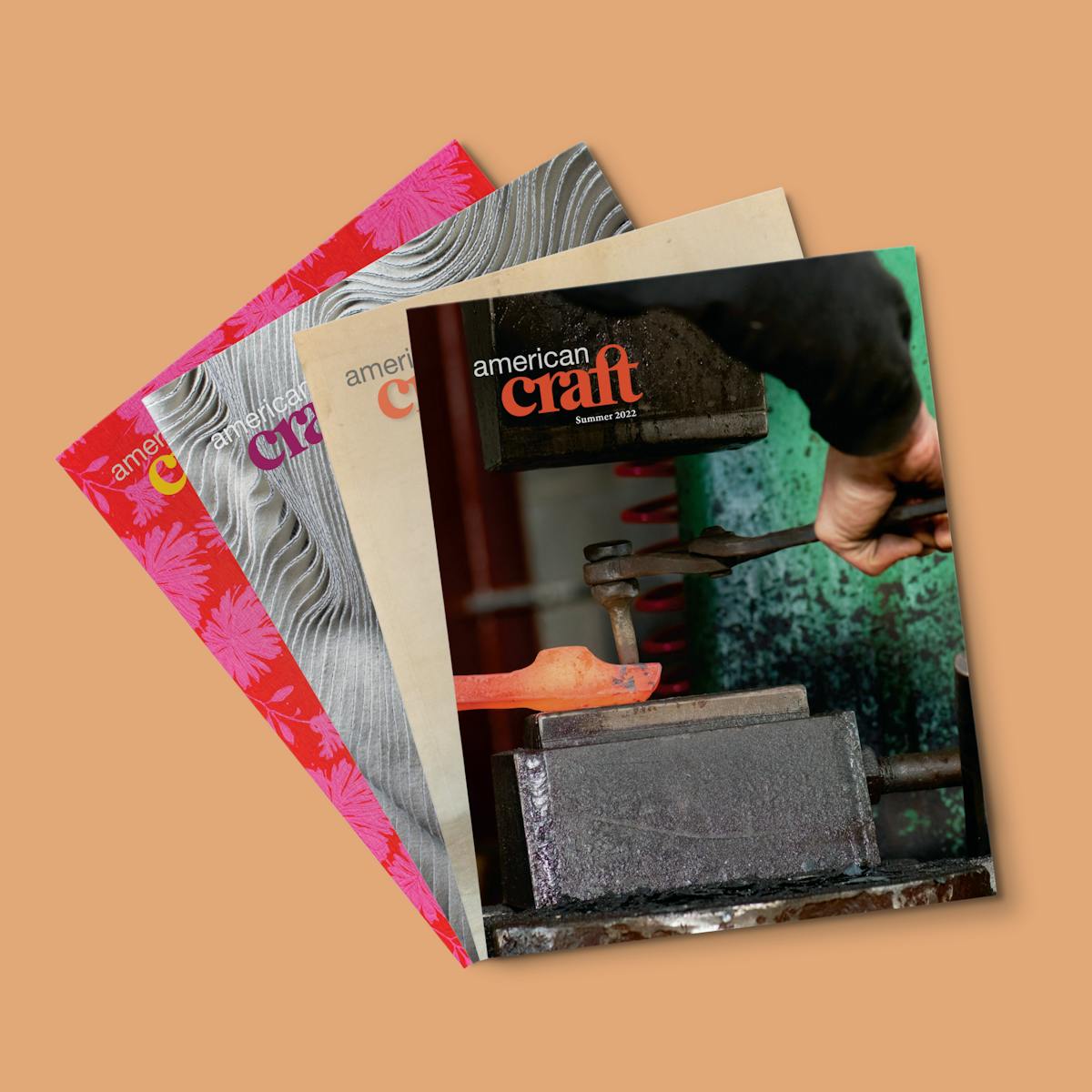Showtime
Showtime

Glass artist Josh Simpson demonstrates glassmaking techniques at the 1974 ACC Northeast Craft Fair held in Rhinebeck, New York. Photo courtesy of the American Craft Council Library & Archives.
When Simpson arrived, he was astounded. The fair was packed not only with collectors, gallery owners, retailers, and museum curators, but also with people curious about craft. “To meet and talk with a craftsperson, and understand why and how they’re making the work, and to get excited by the artist’s vibe, was so thrilling for people,” he recalls. “Delightful interactions happened.”
Those interactions were also fruitful for the artists. At his first show, Simpson sold all of the glass he’d packed into his pickup, took orders for more, and earned enough money to secure a bank loan for a new studio on his grandfather’s land in Connecticut. Simpson participated in every Rhinebeck fair thereafter, until 1983, and then at other locations for decades. He also built a trailer from which he’d give glassblowing demonstrations during the fairs.
The Rhinebeck fair wasn’t actually the beginning of what would become a phenomenon. Since the 1930s, a movement had been afoot in the United States to develop markets in metropolitan areas for rural craftspeople. In 1940 Aileen Osborn Webb formed the Handcraft Cooperative League of America in Vermont, and her friend Anne Morgan started the American Handcraft Council in Delaware. In the same year, America House, a retail outlet operated by the League, opened in New York City. Two years later, Webb and Morgan’s organizations merged and became the American Craftsmen’s Cooperative Council (ACCC)—the precursor to today’s American Craft Council (ACC).
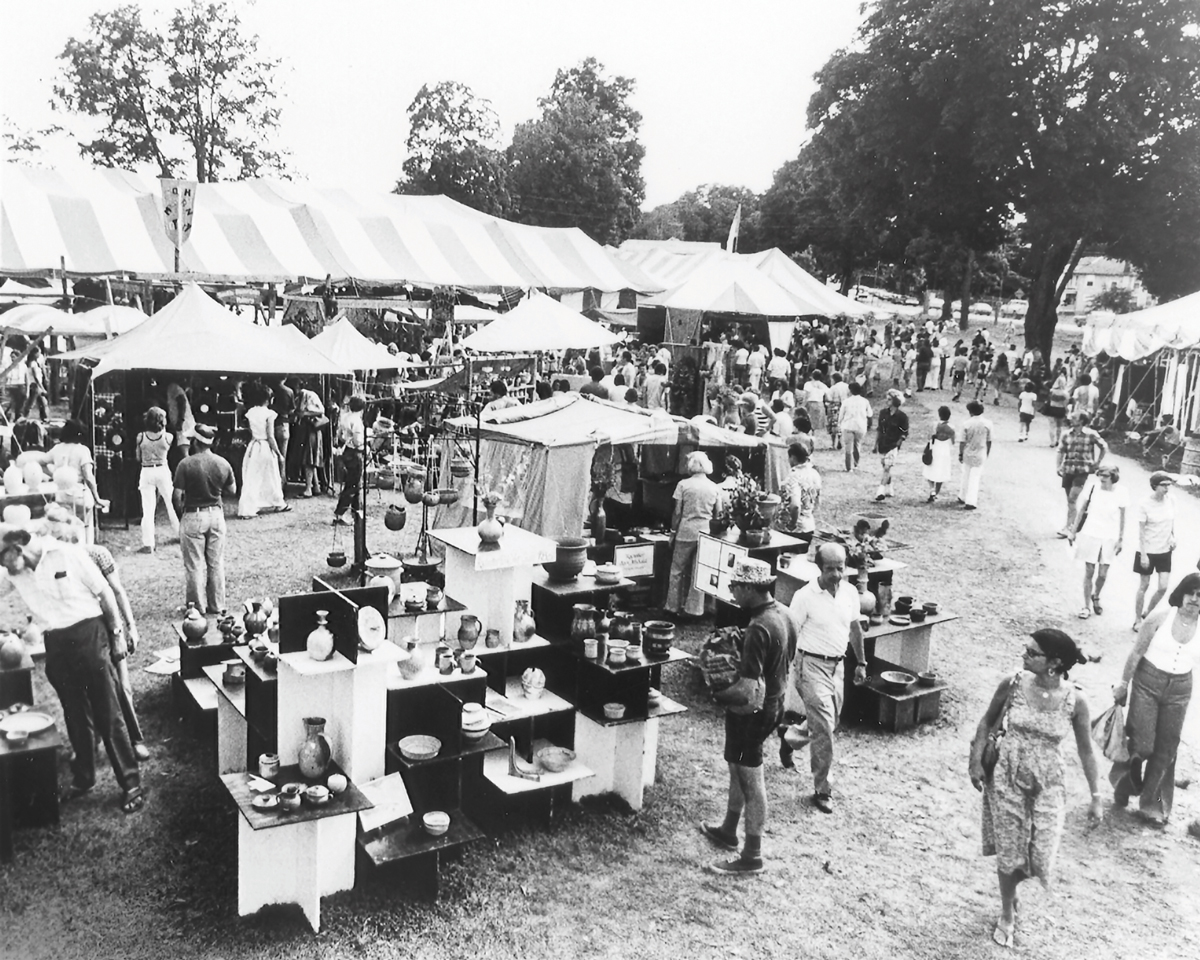
The 1981 Northeast Craft Fair in Rhinebeck, New York. Photo coutesy of the American Craft Council Library & Archives.
By 1955, an educational arm of the ACCC had absorbed that organization and become the American Craftsmen’s Council, which a year later opened the Museum of Contemporary Crafts in New York City. The council began holding annual conferences and exhibitions and, in a bid for wider national impact, set up separate regional programs or “assemblies.” In 1966, the Northeast Regional Assembly of the American Craftsmen’s Council sponsored the first craft fair and conference, titled “Confrontation,” in Stowe, Vermont. More than 175 craftspeople attended, 80 of whom created displays of their work. An auction of work donated by selling participants raised funds to help defray the costs of the fair. The Northeast fair moved to Mount Snow, then Bennington, Vermont, before landing in Rhinebeck in 1973.
As for Josh Simpson, the Rhinebeck fairs he attended weren’t just profitable; they helped him overcome his sense of isolation. “Me and hundreds of other craftspeople realized we were part of a community by doing these shows, which was incredibly important to us,” he says. “We’d all been living and working in the Northeast, but by attending the craft shows we knew we were not alone. We were competitive but enjoyed a camaraderie that was profound.”
Carol Sedestrom Ross, a major force behind launching the Rhinebeck fairs in 1973 as fair committee co-chair, gave “both the artists and the council an ongoing source of income and a platform to meet fellow artists, customers, collectors, curators, and craft retailers,” says Carol Sauvion, who selected artists for her Freehand Gallery from the shows, which had both retail and wholesale days. Weaver John Jameson, whose hand-woven scarves Sauvion carried in her gallery, points out that the shows were also “far more than a shopping experience. They changed people’s understanding of craft in the United States.”
“The shows changed the existence of a generation of craftspeople. Suddenly, there was a marketplace for our work, where none had existed before.”
—Josh Simpson
These early shows emphasized a learning component, and that commitment continued and strengthened when, after many iterations, the American Craftsmen’s Council became the American Craft Council in 1969. Today that mission includes “connect[ing] and galvaniz[ing] diverse craft communities and traditions to advance craft’s impact in contemporary American life.” As such, Jameson says, “the shows are always educational. ACC has always done an excellent job of including hands-on educational elements.”
The Golden Age of Craft
Sedestrom Ross, who died in 2010, was a passionate advocate of the basic craft fair concept. According to a post on the online community Art Fair Insiders, Sedestrom Ross recalled thinking that “If I could just figure out how to start some craft markets, we could have beautiful things made in our own country.” She also saw the fairs as a way to make makers self-sufficient. “Probably 90% of the 500 people who showed in that first fair I organized at Rhinebeck in the early 1970s had some other job,” she told poster Connie Mettler. “When I left Rhinebeck 10 years later probably 90% of the exhibitors were making their living from selling their craft.”
Sedestrom Ross and her team were much beloved “craft mothers,” recalls Jameson. “They would call prior to the show to see if you needed anything and offer advice and tips.” According to Sauvion, Sedestrom Ross also “made pancakes every morning for the ground crew during the Rhinebeck shows at the county fairgrounds. That was truly the craftsperson’s spirit in action!” She urged artists to professionalize by investing in stationery, business cards, and a bank account. “She helped a generation of artists learn how to survive via business strategies,” Simpson says.
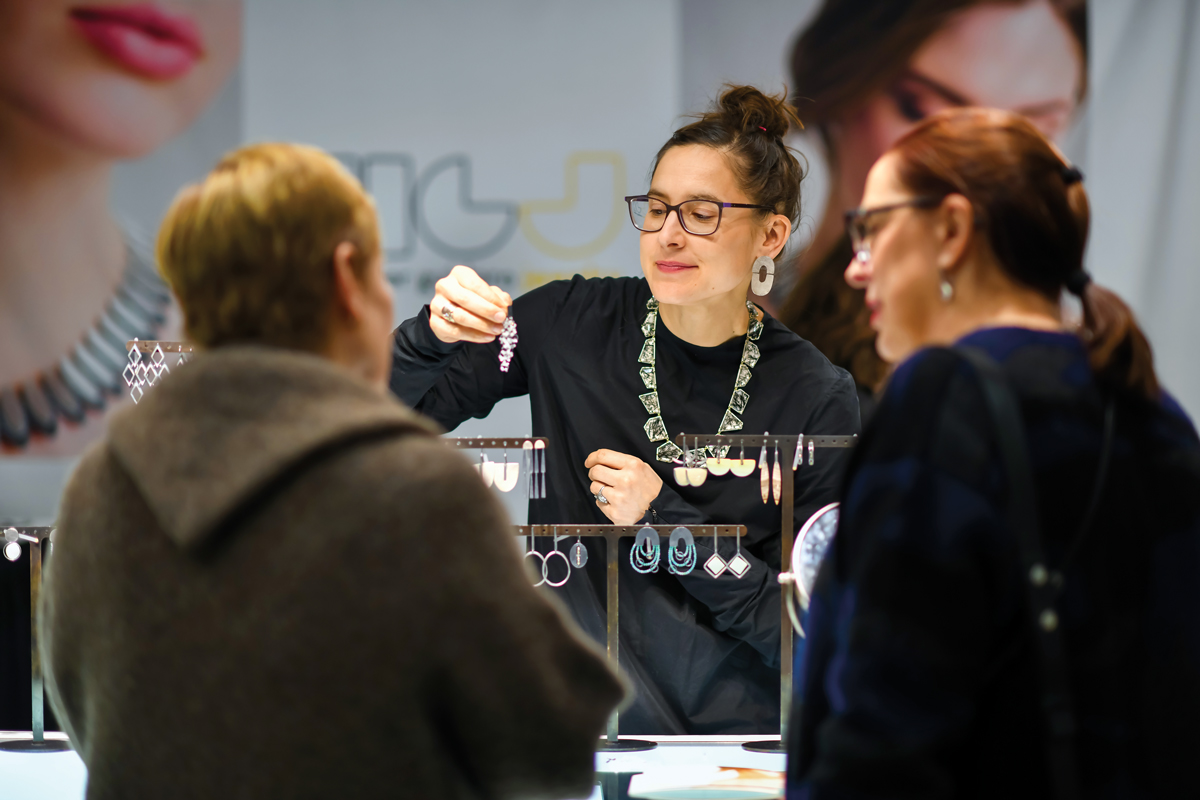
Artist Heather Guidero shows their work at the February 2020 ACC Show in Baltimore, the last show before the pandemic lockdown in March 2020. Photo by Max Franz.
As the number of show participants escalated, Sedestrom Ross initiated a jurying process, which also “became critical to artists’ professional development,” says Perry Price, executive director, Houston Center for Contemporary Craft, and a former director of education for ACC. Because artists had to submit professional photographs of their work, “You had to become a good photographer to make it into the jurying process,” recalls Simpson.
Meanwhile, public interest in craft was also surging. From the late 1970s to early 2000s, ACC assemblies started craft fairs in San Francisco, Baltimore, St. Louis, Dallas, St. Paul, Atlanta, Columbus, Chicago, Charlotte, Tampa, plus Newport, Rhode Island, and Bellevue, Washington. The Rhinebeck show moved to West Springfield, Massachusetts. The Council’s marketing arm, American Craft Enterprises, produced many of the shows.
“Craft boomed and the ACC shows were the center for all craft art,” Simpson says. “The shows changed the existence of a generation of craftspeople. Suddenly, there was a marketplace for our work, where none had existed before.” In 2000, ACC produced three wholesale and eight retail craft shows around the US.
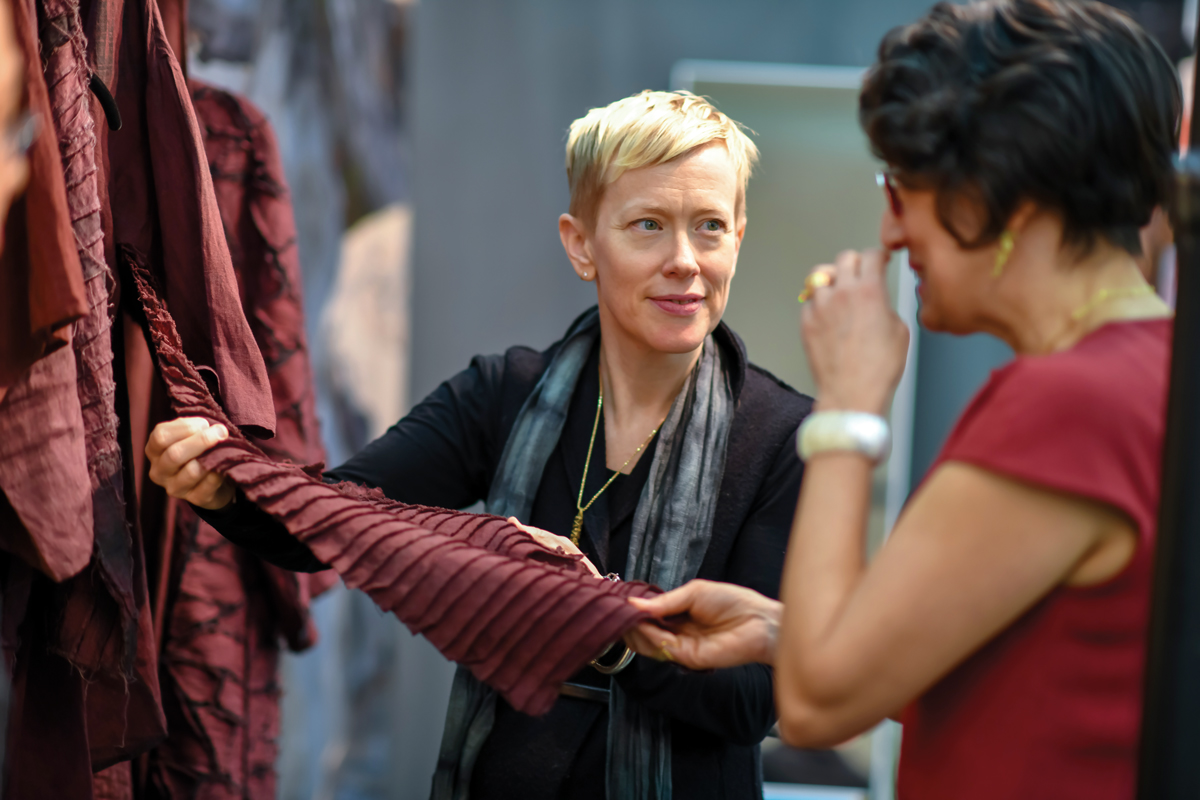
Artist Amy Nguyen shows their work at the February 2020 ACC Show in Baltimore, the last show before the pandemic lockdown in March 2020. Photo by Max Franz.
Simpson attributes the public interest to baby boomers “who were buying and decorating their first homes, and wanted something different than mom’s Tiffany silverware and Dalton china; they wanted the handmade, the irregular, the individualized.” The economy was also flush with Reagan- and Clinton-era disposable income. “As the baby boomers bought second homes, we realized we had a marvelous, ready market of people interested in craft. It was a profound and amazing time.”
Many of the show artists refer to this era as the golden age of craft. “The shows had the imprimatur, the prestige of the American Craft Council,” recalls jewelry designer Keith Lewis. “People would come to you. You’d make a lot of money and make contacts with galleries and museums. The shows were a launch pad for your career.” Sometimes, that career was an unexpected one. Simpson recalls a potter who went to work for Lucasfilm studios, a puppeteer hired by Muppets creator Jim Henson, jewelers lured away by Google, Apple, and Hewlett-Packard.
Sauvion, who created the Craft in America series for PBS and founded the Craft in America Center, says there were many wholesale and retail craft shows during this time, but none compared to the ACC shows. “They were the pinnacle,” she says. And the relationships formed at the shows made them magical. “It was a network of artists, a village, reunited several times a year. A family was formed by the artists who participated.”
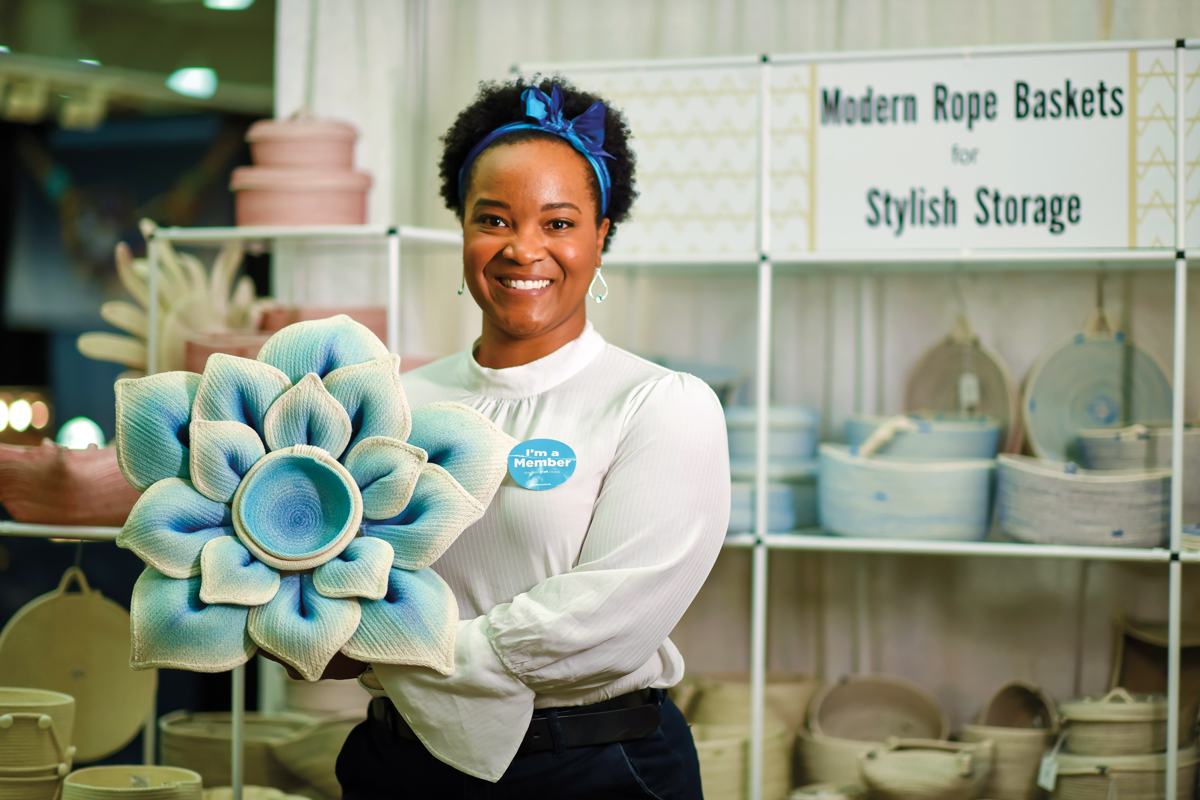
Artist Tenisha Dotstry shows their work at the February 2020 ACC Show in Baltimore, the last show before the pandemic lockdown in March 2020. Photo by Max Franz.
The show artists, who would eat and room together, would also keep tabs on each other. “You might go to a craft show in June and a regular wouldn’t be there,” Simpson recalls, “and we’d learn that their van had broken down or their studio burned.” Over many dinner conversations, Sedestrom Ross, Simpson, and others realized that craftspeople dealing with emergencies—including natural disasters, accidents, and illnesses—were often without a safety net. So they created the nonprofit Craft Emergency Relief Fund (CERF+) in 1985. Since then CERF+ has helped hundreds of artists with more than $1 million in grants, loans, and other services.
Transitions
By 2008, Simpson says, “the crowds at the shows were slowing down.” The causes were myriad, including the financial crisis of 2007–2008 and the internet. ACC conducted an analysis of the market in 2008 and discovered, says former ACC board member and lifetime trustee Barbara Waldman, that “our major competitor was the internet. That was stunning.” Adds Price, “The ubiquity of the internet started changing the way people engaged with craft.”
ACC show artists established websites from which to sell their work and revamped their businesses to deploy social media as a marketing tool. The ACC itself also had to pivot. It hosted “convenings” during its triennial conventions—curated, peer-to-peer conversations giving key stakeholders opportunities to discuss issues, challenges, and concerns in the field. ACC also forged connections between the interior design industry and the craft field; expanded the flagship Baltimore show’s wholesale component to over 700 artists; and debuted its Emerging Artists Program (originally called Hip Pop) at the four shows that remained.
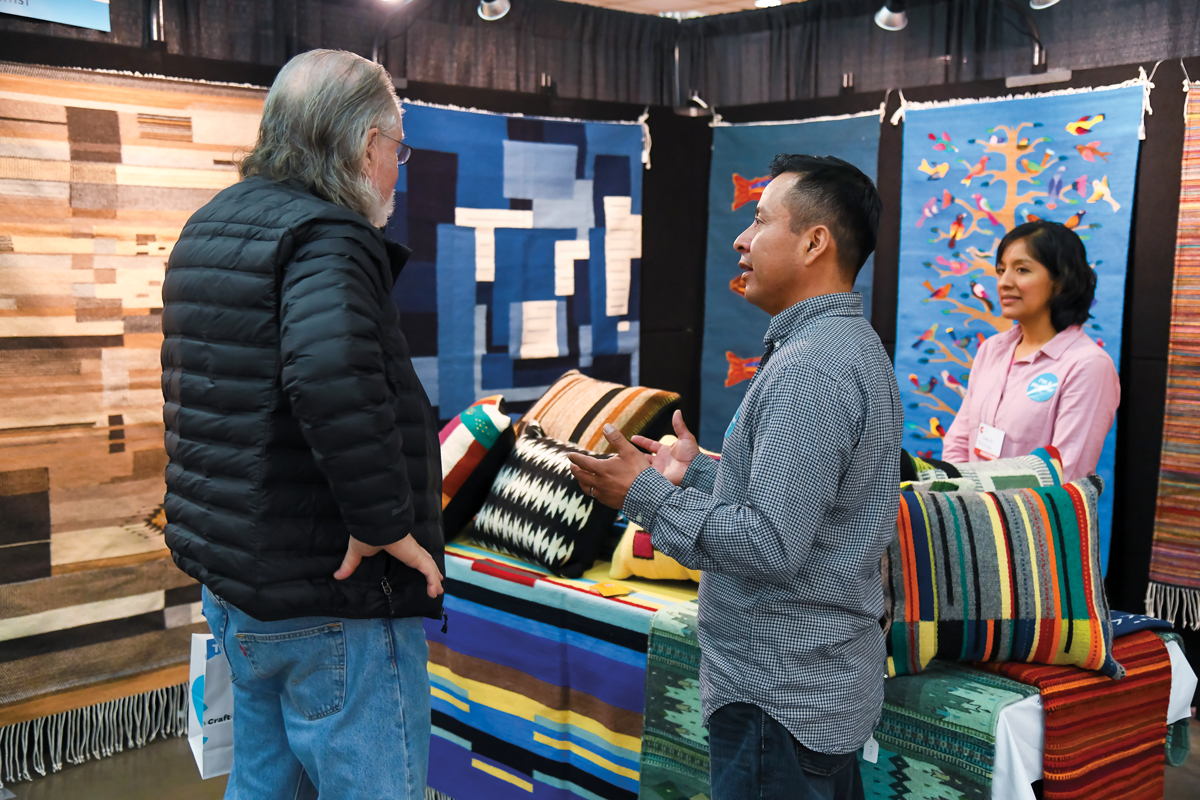
Artist Francisco Bautista shows their work at the February 2020 ACC Show in Baltimore, the last show before the pandemic lockdown in March 2020. Photo by Max Franz.
Artists still enjoyed success. Basketry artist Tenisha Dotstry was chosen for the 2019 Emerging Artists Program and won that year’s Award of Excellence at the Baltimore show. The cohort of eight emerging artists, Dotstry says, “received so much support and preparation from ACC that by the time we got to the show we felt like we all knew each other. It was the best show I’ve ever done.”
Because of ACC’s press and marketing efforts, Dotstry adds, she sold most of her baskets and was featured in a local magazine. She did the show again in 2020 “and placed work on consignment with Contemporary Craft, a museum in Philadelphia. The ACC shows were an amazing starting point for my brand and artwork.”
At the same time, for some artists, the shows aren’t what they used to be, and the internet is the main reason. Josh Simpson, for one, has stopped attending. “After the 2008 financial crisis, the shows became less predictable,” he says, “and there were different ways to purchase things. In 1998, I set up my first website, even though I didn’t think it was an appropriate way to sell work. Now I sell virtually everything on the internet except to some galleries.”
“We need to connect as humans, and craft facilitates that connection. . . . When you enter my booth, you become immersed in my work and my world.”
—John Jameson
“When you turn three-dimensional art into two-dimensional images, you lose something,” says Waldman. “You’re not meeting the artist, not able to feel and touch, to hear the story from the artist. The shows are competing for your time, too; we’re so bombarded with other things to do. Younger generations haven’t been exposed to the shows and don’t understand how valuable they are in becoming educated about craft.”
Present and Future
Immediately following the 2020 Baltimore show, the COVID-19 pandemic closed down the country. “There were already seismic changes occurring in the way people purchase craft, and the pandemic exacerbated that,” Price says. Dotstry, for instance, transferred all of her wholesale and retail sales online. ACC also quickly transitioned its shows. “As a nonprofit, we need to continually seek out new ways to provide services for our artists,” says Kristine Goldy, ACC’s director of marketplace. “We were incredibly lucky that our director of marketing and communications, Keona Tranby, has a background in e-commerce. So we quickly came up with a plan for an online marketplace.”
In 2020 and 2021, the ACC enjoyed a total of four successful online marketplace events, “which confirmed that we need an online presence for our artists,” Goldy says. This year, the ACC relaunches its Baltimore show, now called American Craft Made, online from May 16 to 29, with in-person shopping and events May 20 to 22. “We’re excited to be working with our special craftspeople and community again,” says Goldy. “It will be a whole new world, yet very familiar.”
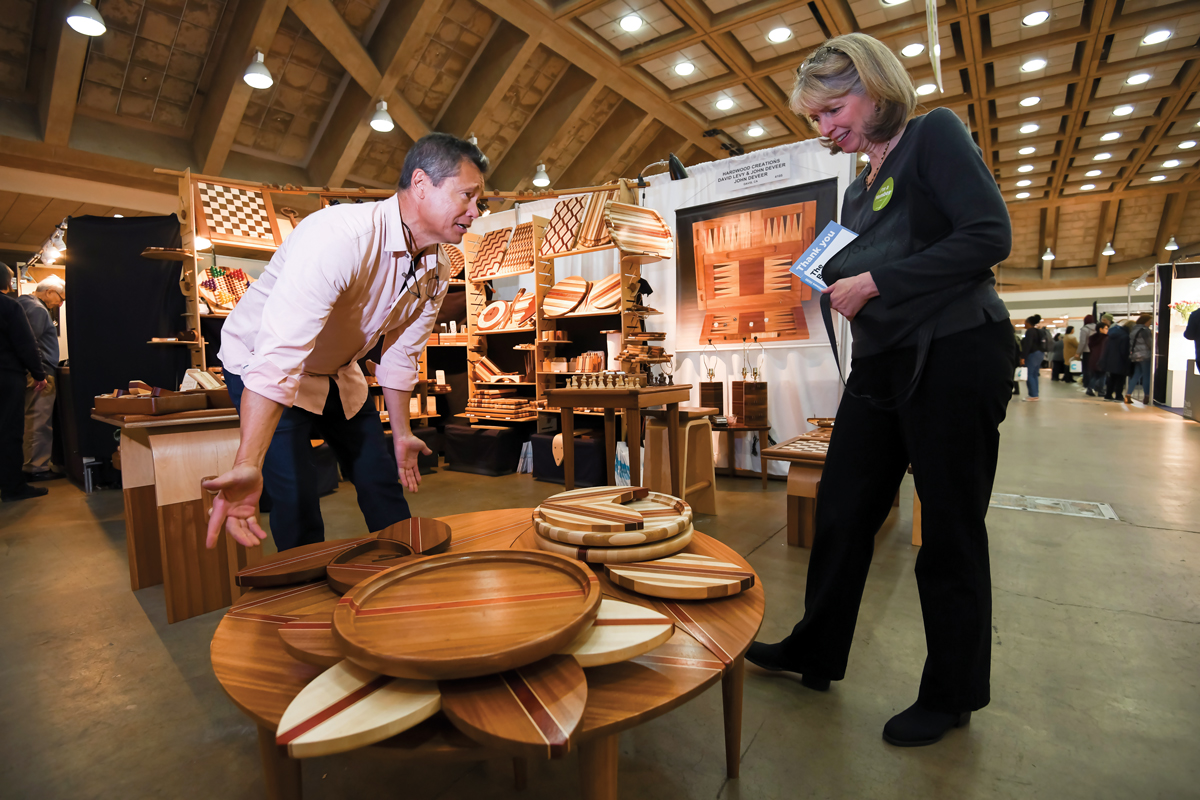
Artist John Deveer shows their work at the February 2020 ACC Show in Baltimore, the last show before the pandemic lockdown in March 2020. Photo by Max Franz.
Price observes that the early Stowe and Rhinebeck shows “are light-years different from the Baltimore shows prior to the pandemic and different from the show this year. But something in the DNA is consistent: It has to do with the one-on-one relationship between craftsperson and consumer.” Jameson, who has a booth at this year’s Baltimore show, says that relationship is rooted in the magic of craft. “We need to connect as humans,” he explains, “and craft facilitates that connection. We use our hands to create an art object; people recognize that and want to talk with us about our inspiration, our choices, the item’s provenance. When you enter my booth, you become immersed in my work and my world.”
And the relationships nurtured can even become multigenerational. Jameson describes clients whose adult children now bring their own children to his booth. “That appreciation for a hand-knit scarf or mouth-blown glass gets passed down through the generations,” he says, “creating a circle of life full of inspiration. For this reason alone, we will always need the ACC shows.”
Discover More Inspiring Stories in Our Magazine
Become a member to get a subscription to American Craft magazine and experience the work of artists who are defining the craft movement today.
